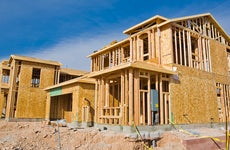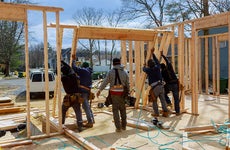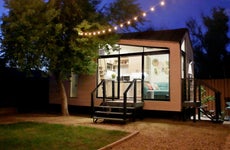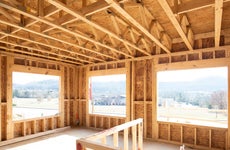What are the cheapest ways to build a house?
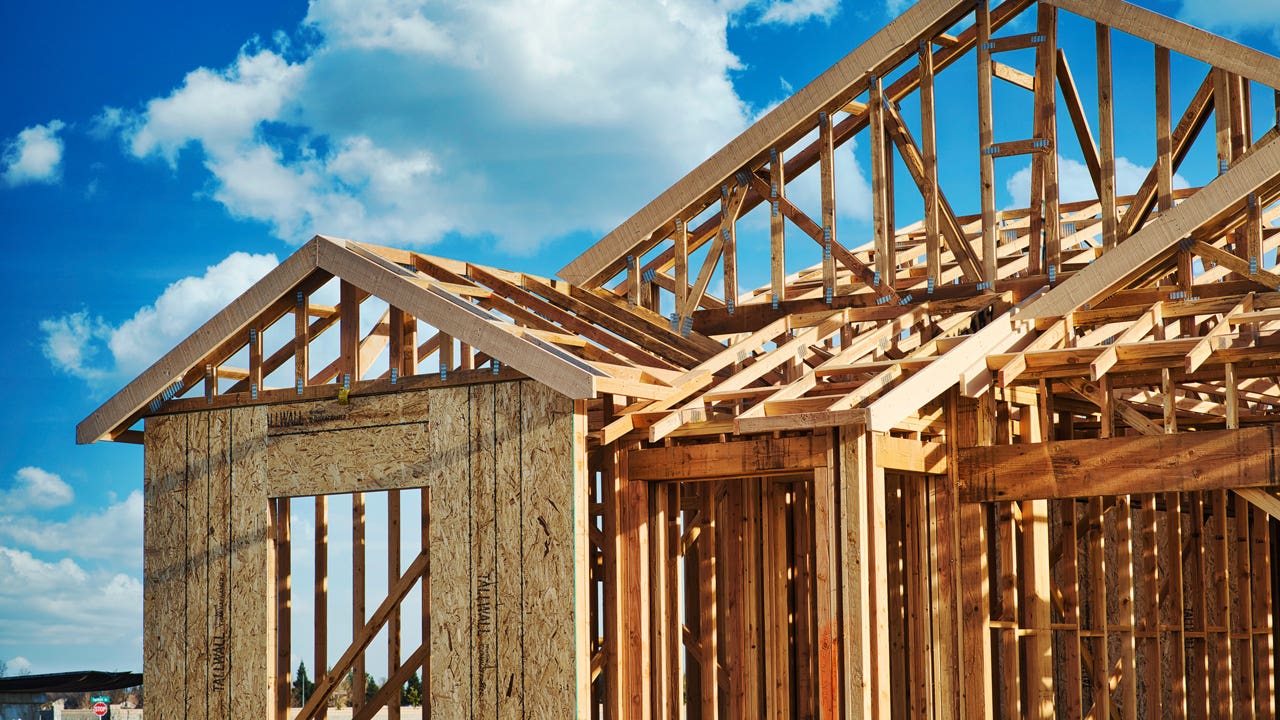
The Bankrate promise
At Bankrate we strive to help you make smarter financial decisions. While we adhere to strict , this post may contain references to products from our partners. Here's an explanation for .
You’ve searched the home listings, but alas, you’ve come up empty. Sure, there are homes for sale in your desired area, and some even have a few of the features you covet most. But ultimately, you haven’t found your dream home that checks every box.
You could build your own home to meet your needs and wish list. Building your own home has many pluses, but it can be pricey both in money and time. And with interest rates on the rise, you don’t want to borrow a lot in construction loans.
Fortunately, there are ways to economize and save money. Here are the cheapest ways to build a house.
How much does building a home cost?
Data suggests it may be cheaper to build a new home than to buy an existing one. According to a HomeAdvisor study, the average cost to build a house in 2022 is $279,810. By contrast, the median home price in the U.S. was $439,400, according to data from the U.S. Census Bureau and the U.S. Department of Housing and Urban Development.
As prices vary widely across the country, the costs to build your own house may be higher or lower in your area. It’s also worth noting that supply chain shortages are driving up costs across all sectors, including building materials and home appliances.
Some of the most significant factors in the cost of building a new home include:
- Size: As a general rule, the larger the home, the greater the costs. Most home builders base cost estimates on the square footage of a home. According to HomeAdvisor, the average cost to build a new home nationwide is $150 per square foot.
- Design and layout: A simple, single-story design is more cost-efficient than a custom one with many corners and intricate roof lines. That’s because every corner and angle requires the building material — like lumber, drywall, roof shingles — to be cut, with excess material getting thrown away.
- Features: Exotic stone countertops, wood-like floor tiles and customized cabinets can make your home stand out, but anything non-standardized comes at a higher cost.
- Supply and demand: Building prices are typically higher where demand is greater than supply. In rapidly growing areas, more demand for materials and contractors drives up prices.
What are cheaper types of houses?
Not all types of housing are created equal. You’ll likely save money on your home build by opting for a non-traditional home type — something other than the time-honored stick-built house, a completely customized, built-on-site structure.
Prefab home
Prefabricated homes, often referred to as “prefab,” are made in a factory with some level of assembly or construction at the home site. According to HomeAdvisor, the cost to build a 1,800-square-foot modular prefabricated home averages $270,000.
The most common types of prefab homes are modular and manufactured. The primary difference between modular and manufactured homes is that modular homes are permanent structures while manufactured homes can be moved.
- Modular: These homes are constructed on-site in modular units, with materials delivered from the factory. You can customize your prefab home, although not as freely as a regular custom-built house.
- Manufactured: Manufactured homes (once referred to as mobile homes) are built and transported in sections: single-wide, double-wide and triple-wide. Unlike modular homes, which must adhere to local building codes, manufactured homes must abide by federal building codes issued by the U.S. Department of Housing and Urban Development (HUD).
Tiny home
A tiny home may be the cheapest house to build. Generally, a tiny home is a living structure under 600 square feet, with the average size for a tiny house only 225 square feet, according to a Porch.com survey. The study also found the average price for a tiny home in the U.S. is $52,000, 87 percent cheaper than a traditional home.
Edna and Juan Forero of Jupiter, Florida, built a tiny home for their daughter to live in while enrolled in graduate school. “We were fascinated with the tiny home concept and the financial freedom that comes with a moveable but mortgage-free home,” said Edna. The couple compared the costs of building a tiny home against the rental rates for apartments. “While our build cost of $22,000 was similar to the cost of 18 months of rent after school finished, she would have a permanent home to live in and take wherever she goes in the future.”
Barndominium
As its name implies, a barndominium combines the features of a barn and a condominium. A barndominium can be a converted barn or a brand-new building constructed in the shape of a barn. The merging of rural and urban architecture, along with their affordability and faster construction timeline, contribute to the rising popularity of these homes.
“Barndos” are often cheaper and faster to build than traditional homes because they typically come in prefab kits that make up the metallic exterior structure of the building. Keep in mind, you’ll have to provide the concrete slab and create the interior layout.
According to HomeAdvisor, the average cost of a barndominium costs $225,600 to $288,000 for 2,400 square feet.
Cheaper building materials
One of the best ways to save on building costs is to choose less expensive building materials. Consider these cost-effective options:
- Reclaimed materials: Using reclaimed materials like old wood, brick and barn doors not only adds some individuality to your new home, it also can save you money. Check online sites like Facebook Marketplace and salvage stores for used doors, flooring, windows and lighting.For Ralph McLaughlin, a retired police officer from Phoenix, finding inexpensive materials was a fun way to save money on his new home build. “We found deals all over the place,” said McLaughlin. “We got ceramic lighting and we did our paint on them. The chandeliers look expensive, they were slightly damaged but you couldn’t even tell, and I got a deal on those.”
- Prefab panels: Prefabricated panels are walls constructed in a factory and shipped to your home site. Building your interior walls in this manner can save on construction costs and the cost of labor to frame and drywall the wall.
- Precast concrete: Similar to prefab panels, precast concrete is poured, cured and shipped to your property. Precast concrete reduces the need for on-site labor, lowering your costs.
Cheaper home styles
The architectural style of a home is one of the most significant cost factors. For example, a Mediterranean home with two floors and a roof of expensive terra-cotta tiles may be more expensive to build than a similarly sized single-level cottage or bungalow with a more conventional roof.
Ranch-style homes are not only popular but also one of the most cost-efficient home styles to build. These homes typically come in a rectangular shape, though many resemble “T” or “S” shapes. The ranch style’s simple layout reduces complications in construction.
Similarly, the symmetrical floor plan and square silhouette that characterize colonial-style homes make them less expensive to build than, say, irregularly fronted Victorian-style houses.
“Learn to love the box,” says architect Lee Calisti, a strategic construction advisor at Real Estate Bees, a platform for industry professionals. “The box is the most straightforward and affordable thing to build.”
Other cheap house-building tips
Building your own home may be more affordable than purchasing an existing home. These cost-saving tips may help you save even more money up-front and in the long run:
- DIY where possible: Are you skilled at landscaping? Or perhaps you have a keen sense of style and can design your home’s interior, from countertops to light fixtures. Look for simple tasks such as interior painting, light and ceiling fan installations, and shelving you can do yourself.
- Hire a general contractor: Unless you’re an experienced builder or developer with an extensive network of skilled laborers, you may wish to hire a general contractor to oversee construction. Yes, they charge a fee, but by overseeing all the other tradespeople involved in the build, they can help you avoid making costly and time-consuming mistakes. Having a GC build your home from a pre-existing floor plan, instead of having an architect design it totally from scratch, can save money too.
- Use eco-friendly and energy-efficient systems: Using energy-efficient materials like top-grade insulation and high-efficiency windows is good for the environment and a great way to economize — in the long run. For example, installing solar panels may cost more upfront, but it may save you substantial money over the years. Through the Inflation Reduction Act, passed in August 2022, you may qualify for rebates and tax breaks to reduce your construction costs, too. Search EnergyStar.gov for details on federal tax credits and rebates available to you.
Final word on building a house for less
The cheapest ways to build a house boil down to two sorts of KISS: “Keep it simple stupid” and “Keep it small stupid.”
That said, you should never skimp on items that involve safety and health, such as the foundation or the roof. When it comes to HVAC systems, it might be worth it to invest more now in a state-of-the-art energy efficient system that can save in energy costs in the future.
Being frugal doesn’t mean you have to sacrifice style completely. Calisti advises spending strategically and splurging where it matters most. “Public spaces such as the kitchen, dining and living room can have a higher degree of finish [as opposed to] the bedrooms and bathrooms,” he says.
Related Articles
